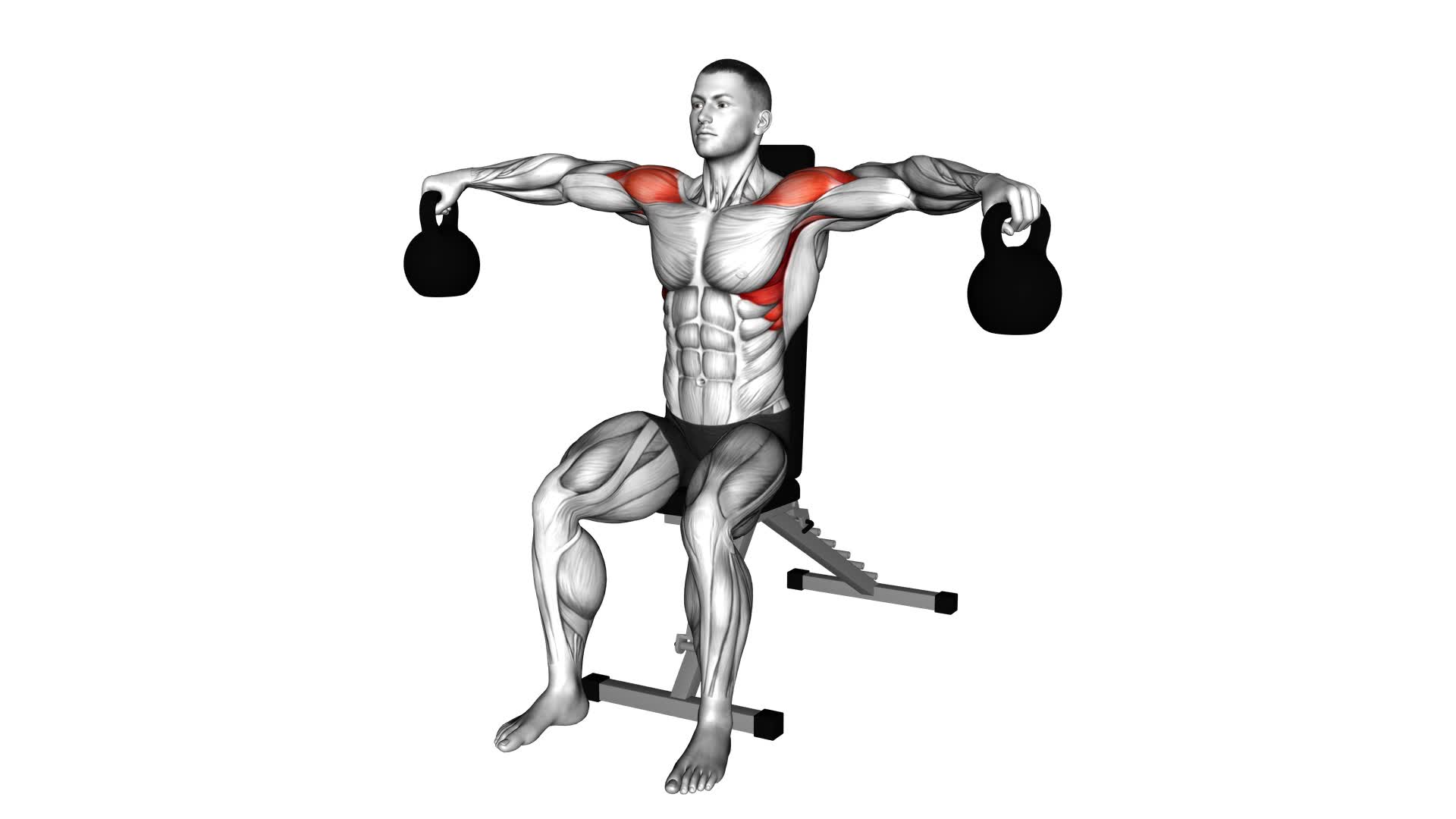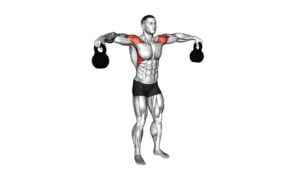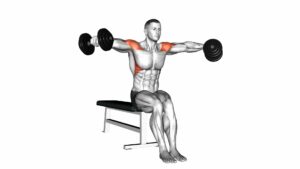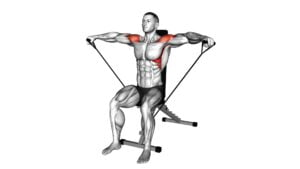Kettlebell Seated Lateral Raise – Video Exercise Guide & Tips

Are you looking for an effective shoulder exercise? Look no further than the Kettlebell Seated Lateral Raise.
Watch This Exercise Video
This exercise targets your deltoids and helps to build strong, defined shoulders.
In this video exercise guide, you'll learn the proper form and technique, as well as tips for choosing the right kettlebell weight and avoiding common mistakes.
Follow along and get ready to take your shoulder workout to the next level!
Key Takeaways
- Targets deltoid muscles for strong, defined shoulders
- Adds resistance for a more challenging and effective exercise
- Strengthens and tones muscles in shoulders, upper back, and core
- Gradually increases strength over time
Benefits of Kettlebell Seated Lateral Raise
You can experience improved shoulder strength and stability with the kettlebell seated lateral raise. This exercise specifically targets the deltoid muscles, which are responsible for lifting your arm to the side. By incorporating the kettlebell into this movement, you add resistance, making the exercise more challenging and effective.
One of the key benefits of the kettlebell seated lateral raise is that it helps to strengthen and tone the muscles in your shoulders. As you lift the kettlebell to the side, your deltoids are engaged, and this repetitive motion helps to build strength over time. Additionally, this exercise also targets the muscles in your upper back and core, contributing to improved overall stability.
Proper form is crucial when performing the kettlebell seated lateral raise. Start by sitting on a bench or chair with your feet flat on the floor. Hold the kettlebell in one hand, with your palm facing inward. Keep your back straight and engage your core. Lift the kettlebell to the side, making sure to control the movement and avoid any swinging or jerking motions. Repeat on both sides for a balanced workout.
Incorporating the kettlebell seated lateral raise into your fitness routine can lead to stronger, more stable shoulders and improved overall upper body strength. Remember to start with a weight that you can comfortably handle and gradually increase as you become stronger.
Proper Form and Technique
To perform the kettlebell seated lateral raise with proper form and technique, start by sitting on a bench or chair and placing your feet flat on the floor. Hold the kettlebell in one hand, with your arm extended down by your side, palm facing inwards. Keep your core engaged and your back straight throughout the exercise.
The most common mistake people make during this exercise is using momentum to lift the kettlebell instead of relying on their shoulder muscles. Remember to focus on using your shoulder muscles to lift the weight, rather than swinging or jerking your arm.
For progression, you can start with a lighter weight and gradually increase the weight as you become more comfortable and stronger. It's important to maintain control and proper form throughout the movement, so don't rush the progression process.
Transitioning into the next section about choosing the right kettlebell weight, it's crucial to select a weight that challenges you but still allows you to maintain proper form and technique. Choosing the right weight will ensure that you get the most out of your kettlebell seated lateral raise and minimize the risk of injury.
Choosing the Right Kettlebell Weight
When it comes to choosing the right kettlebell weight, there are a few key points to consider.
For beginners, it's important to start with a weight that allows you to maintain proper form and technique throughout the exercise.
As you progress, you can gradually increase the weight to continue challenging your muscles and seeing improvements in strength and endurance.
Weight for Beginners
Start with a kettlebell weight that feels challenging but manageable for your fitness level. This is important to ensure that you can perform weightlifting techniques with proper lifting form. Choosing the right weight will help you avoid injury and maximize your progress.
Consider the following tips when selecting your kettlebell weight:
- Start with a lighter weight to focus on mastering proper form and technique.
- Gradually increase the weight as you become more comfortable and confident with your lifts.
- Listen to your body and pay attention to any discomfort or strain. It's better to start lighter and progress slowly than to risk injury.
- Consult with a fitness professional if you're unsure about the appropriate weight for your fitness level.
Progressive Increase in Weight?
Gradually increase the weight of your kettlebell as you become more comfortable and confident with your lifts. This progressive increase in weight is important to continue challenging your muscles and increasing the intensity of your workouts.
However, it's crucial to choose the right kettlebell weight that allows you to maintain proper form and technique throughout each exercise. Before increasing the weight, make sure you have mastered the proper warm-up techniques and have built a solid foundation of strength and stability. This will help prevent injuries and ensure you get the most out of your workouts.
Listen to your body and only increase the weight when you feel ready. Remember, it's better to start with a lighter weight and gradually increase as you progress rather than going too heavy and risking injury.
Variations and Modifications
To add variety and challenge to your kettlebell seated lateral raise, you can explore different variations and modifications. Here are four options to consider:
- Single-arm seated lateral raise: Instead of using both arms simultaneously, try performing the exercise with one arm at a time. This variation allows you to focus on each side independently, improving muscle imbalances and enhancing overall stability.
- Alternating seated lateral raise: Instead of raising both arms at the same time, alternate between the left and right sides. This variation adds an element of coordination and control to the exercise, engaging your core and challenging your balance.
- Seated lateral raise with a resistance band: If you don't have access to kettlebells, you can use a resistance band instead. Attach the band to a sturdy anchor point and hold the handles with your hands. Perform the exercise in the same seated position, keeping the band taut throughout the movement.
- Seated lateral raise with a twist: Add a rotational component to the exercise by twisting your torso as you lift the kettlebell. This modification targets your obliques and adds a functional element to the movement.
Common Mistakes to Avoid
To prevent common mistakes and get the most out of your kettlebell seated lateral raise, you need to focus on proper form and technique.
One common mistake is using too heavy of a weight. It's important to start with a weight that you can comfortably lift and control throughout the exercise. Using a weight that's too heavy can lead to improper form and increased risk of injury.
Another mistake to avoid is using momentum to lift the kettlebell. This can happen when you swing your body or use a jerking motion to raise the weight. Instead, focus on using the muscles in your shoulders and arms to lift the kettlebell in a controlled manner.
Additionally, it's important to maintain proper posture throughout the exercise. Avoid slouching or leaning back, as this can put unnecessary strain on your back and neck. Keep your spine straight and engage your core for stability.
Tips for Progression and Safety
To ensure proper progression and maintain safety during the kettlebell seated lateral raise, you should focus on gradually increasing the weight and maintaining proper form throughout the exercise. Here are some progression tips and safety precautions to keep in mind:
- Start with a lighter kettlebell and gradually increase the weight as you become more comfortable with the exercise. This will help you avoid straining your muscles and reduce the risk of injury.
- Keep your back straight and core engaged throughout the movement. This will help protect your spine and maintain stability during the exercise.
- Avoid using momentum to lift the kettlebell. Instead, focus on using your shoulder muscles to perform the lateral raise. This will ensure that you're targeting the right muscles and getting the most out of the exercise.
- If you experience any pain or discomfort during the exercise, stop immediately and consult a fitness professional or healthcare provider. It's important to listen to your body and avoid pushing through pain, as this can lead to further injury.
Frequently Asked Questions
How Many Sets and Reps Should I Do for the Kettlebell Seated Lateral Raise?
For the kettlebell seated lateral raise, it's important to consider your shoulder injury precautions. Start with a weight that allows you to maintain proper form and control. Aim for 3-4 sets of 8-12 reps to build strength and endurance.
Remember, you can always adjust the weight and reps based on your fitness level.
Additionally, there are variations of the lateral raise, such as using dumbbells or resistance bands, that you can try to target your shoulder muscles from different angles.
Can I Do the Kettlebell Seated Lateral Raise if I Have a Shoulder Injury?
If you have a shoulder injury, it's important to modify exercises to avoid further damage.
The kettlebell seated lateral raise can be modified by using lighter weights or resistance bands.
However, it's always recommended to consult a physical therapist before attempting any exercise that may aggravate your injury.
They can provide guidance on proper form and help you determine if the kettlebell seated lateral raise is suitable for your specific condition.
What Muscles Does the Kettlebell Seated Lateral Raise Target?
The kettlebell seated lateral raise targets multiple muscles in your upper body. It primarily works your lateral deltoids, which are the muscles on the sides of your shoulders. This exercise also engages your trapezius, rhomboids, and upper back muscles, helping to improve your posture.
The kettlebell seated lateral raise is an effective exercise for strengthening and sculpting your shoulders and upper body. To perform it correctly, remember to maintain proper form and technique throughout the movement.
Is It Necessary to Warm up Before Performing the Kettlebell Seated Lateral Raise?
Before performing the kettlebell seated lateral raise, it's highly recommended to warm up. Warming up helps prepare your muscles and joints for the exercise, reducing the risk of injury. It also increases blood flow, flexibility, and range of motion.
For beginners, it's important to start with lighter weights and focus on proper form. Gradually increase the weight as you get stronger and more comfortable with the exercise.
Can I Incorporate the Kettlebell Seated Lateral Raise Into My Full-Body Workout Routine?
Yes, you can definitely incorporate the kettlebell seated lateral raise into your full-body workout routine.
This exercise is a great way to target your shoulder muscles and improve upper body strength.
By incorporating kettlebell exercises like the seated lateral raise, you won't only work your shoulders but also engage your core and improve stability.
The benefits of the seated lateral raise include increased shoulder stability, improved posture, and enhanced upper body strength.
Conclusion
In conclusion, the kettlebell seated lateral raise is a highly effective exercise that targets the shoulder muscles. By maintaining proper form and technique, choosing the right kettlebell weight, and avoiding common mistakes, you can maximize the benefits of this exercise.
Additionally, incorporating variations and modifications can help to further challenge your muscles. Remember to progress gradually and prioritize safety throughout your workouts.

Author
Years ago, the spark of my life’s passion ignited in my mind the moment I stepped into the local gym for the first time. The inaugural bead of perspiration, the initial endeavor, the very first surge of endorphins, and a sense of pride that washed over me post-workout marked the beginning of my deep-seated interest in strength sports, fitness, and sports nutrition. This very curiosity blossomed rapidly into a profound fascination, propelling me to earn a Master’s degree in Physical Education from the Academy of Physical Education in Krakow, followed by a Sports Manager diploma from the Jagiellonian University. My journey of growth led me to gain more specialized qualifications, such as being a certified personal trainer with a focus on sports dietetics, a lifeguard, and an instructor for wellness and corrective gymnastics. Theoretical knowledge paired seamlessly with practical experience, reinforcing my belief that the transformation of individuals under my guidance was also a reflection of my personal growth. This belief holds true even today. Each day, I strive to push the boundaries and explore new realms. These realms gently elevate me to greater heights. The unique combination of passion for my field and the continuous quest for growth fuels my drive to break new ground.







